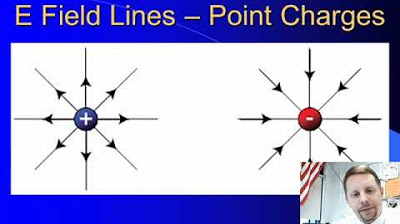Electric Fields: Crash Course Physics #26
TLDRThis video explains electric fields, which are generated by charged particles and exert forces on other charges. It starts with Coulomb's Law for calculating forces between point charges. Then it introduces the concept of electric fields, which describe the force per unit charge on a test charge at any point in space near a charged object. Properties of electric field lines are discussed. Applications like capacitors and conductors are analyzed using field concepts. Overall, the video aims to show how electric fields allow us to describe the effect of any charged configuration on surrounding space.
Takeaways
- 😀 Coulomb's law calculates forces between charged particles, but we need more concepts to describe complex electric situations
- 🌟 Faraday introduced the idea of an electric field generated by charged objects that exerts force on other charges
- 🔌 The electric field can be calculated mathematically using force and charge values
- 👆 Electric field lines show the direction and magnitude of force exerted on positive test charges
- ↔️ The properties of electric field lines help describe the overall field in complex situations
- 🌩 Adding fields of multiple charges gives the overall field (superposition principle)
- ⏺ Electric field lines start on positive charges and end on negative charges
- 📐 Field lines never cross each other
- ⚡ Capacitors use electric fields to store charge
- 🔋 Electric fields inside conductors are zero when in static equilibrium
Q & A
What is an electric field and how is it generated?
-An electric field is a measurable effect generated by any charged object. It carries energy and passes it on to other charged materials by exerting electric forces.
How do you calculate the electric field created by a point charge?
-You can calculate it using the equation: Electric field = Electric force / Magnitude of test charge. You can also plug Coulomb's Law into this equation.
What are some key properties of electric field lines?
-Some key properties are: 1) Field lines are tangent to the direction of the field, 2) Greater line density signifies greater field magnitude, 3) Lines start from positive charges and end at negative charges, 4) Lines never cross.
Why is there no electric field inside a conductor at electrostatic equilibrium?
-When a conductor reaches electrostatic equilibrium, the excess charges distribute themselves to reduce net forces. Since electric field represents forces on charges, no net forces means no electric field inside.
How does putting a positive charge inside a conductive shell generate an electric field?
-The positive charge attracts negative charges to the inside of the shell. This leaves the outer shell with a net positive charge, creating an outward electric field.
What is an electric dipole?
-An electric dipole consists of two particles with equal and opposite charges some distance apart. Their fields can be added using the principle of superposition.
How do capacitors use electric fields?
-Capacitors store charge using the electric field between their positive and negative plates.
Why do electric field lines keep going to infinity if there are no negative charges?
-Electric field lines always seek out negative charges. If none exist, the lines continue forever seeking negative charges.
How does grouping charged particles change their overall electric field?
-Grouped particles can look very different when viewed from far away versus up close. Their overall field depends on the net charge.
What is the purpose of diagramming electric fields with field lines?
-Electric field line diagrams show the magnitude and direction of force on a positive test charge. This allows visualization of the field.
Outlines
🤔 Understanding electric forces beyond Coulomb's Law
This paragraph introduces the need to describe complex electric force situations beyond what Coulomb's Law allows for. It mentions that Coulomb's Law works for small charged particles, but we need to also understand fields generated by larger charged objects that power everyday electric devices. The concept of electric fields is introduced - fields exert forces on charges.
🌟 Introducing electric fields and their properties
This paragraph formally introduces electric fields - the effect generated by a charged object that exerts forces on other charges. Equations are provided for calculating electric fields. Vector field diagrams are introduced to visualize the magnitude and direction of forces. Important properties of field lines are covered - they point in direction of force on + charge, line density shows magnitude, lines start from + and end at - charges, and lines never cross.
Mindmap
Keywords
💡electric field
💡field lines
💡superposition
💡dipole
💡capacitor
💡conductor
💡electrostatic equilibrium
💡Coulomb's Law
💡charge
💡electromagnetism
Highlights
Charged particles exert electrostatic forces on one another that can be calculated using Coulomb's Law
Electric fields carry energy, passing it to charged materials by exerting electric forces
Electric field lines show the magnitude and direction of the force on nearby charges
The density of electric field lines indicates the field's magnitude
Field lines start from positive charges and end on negative charges
Field lines must not cross each other
Groups of charges can appear differently when viewed from a distance
Capacitors use electric fields to store charge
Electric field inside conductors is zero when at electrostatic equilibrium
Excess charge distributes on a conductor's surface
Neutral conductors develop internal and external electric fields in the presence of internal charges
Electric fields describe the effect of charged objects on surrounding space
Electric forces and fields relate to the larger concept of electromagnetism
All charged objects generate electric fields affecting other charges
Electric fields interact with capacitors and conductors
Transcripts
Browse More Related Video

What is the Electric Field? How do Electric Forces Work?

High School Physics - Electric Fields

Gauss Law Problems - Infinite Sheet of Charge and Parallel Plate Capacitor - Physics

Electric Field, Force, Potential, Potential Energy (AP Physics SuperCram Review)

Lecture 7 | Quantum Entanglements, Part 3 (Stanford)

How To Draw Electric Field Lines of Point Charges - College Physics
5.0 / 5 (0 votes)
Thanks for rating: